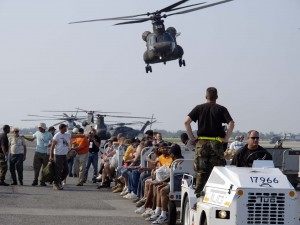 The research spread to St. Bernard and Plaquemines parishes, the Westbank and Baton Rouge.
The research spread to St. Bernard and Plaquemines parishes, the Westbank and Baton Rouge.
On 6.28.07 Dwight Brashear, who was brought in to run the transportation desk marshaling commandeered school buses, described the scene at the state OEP to me. On 12.28.07, I interviewed Lt. Gov. Mitch Landrieu who relived a night when he drove one of eight buses filled abandoned Superdome evacuees in a convoy to Lafayette. I interviewed Gretna PD Chief Arthur Lawson on 8.12.08, and Gretna Mayor Ronnie Harris on 8.22.08, who both helped shed light on ‘another chapter’. I also interviewed LAANG CWO5 Kevin Dares, and his brother and fellow Katrina responder retired LDWF MAJ Sandy Dares.
M. Darryl Woods, Lead Researcher
thecontraflow@yahoo.com

Coming to what I believed was the end of my research, I had just one question, which was for Delta Airlines. Why were the Omaha-bound evacuees not informed of their destination until before landing?
To my surprise, I was granted an interview by two Delta executives on 7.7.06, who as 757 pilots flew Delta CEO Gerald Grinstein into Armstrong Airport on a humanitarian mission to deliver provisions and pick up evacuees. After hearing Capt. Joe Kolshak and Capt Mike Quiello’s amazing heartfelt accounts, my 7th Ward blinders were removed and Armstrong Airport quickly became the next major focus of our research.
I then started documenting other parts of the city such as Algiers, Lakeview, 9th Ward, N.O. East. It was then when I started comprehending evacuees migration pattern out of the city through major collection points like the Superdome, Morial Convention Center, Algiers Point Ferry Terminal, I-10 & Causeway and MSY. It was the beginning of my six-phased evacuation theory.
M. Darryl Woods, Lead Researcher
thecontraflow@yahoo.com

On 11.11.05, I landed in New Orleans for what was scheduled to be a four-day visit. Armed with a video camera, I was given a tour by Mathieu of his devastated hometown. It was a disaster zone like no other. There were tens of thousands of damaged homes and virtually no signs of life.
Eventually, we came upon a “camp” that was bustling with two dozen volunteers. It was the home of a community leader named Dyan French Cole, aka Mama D, who invited me to stay. All I had to do was wake up, turn on the camera and walk outside. People came from near and far to see Mama D. I soon branched out from her home base camp and went on to document the repopulation of New Orleans. I listened to over 1,000 relief workers and returning survivors. It was during this surreal period leading up to Mardi Gras, 2.28.06, that I found myself becoming a literary advocate for the Katrina survivors.
M. Darryl Woods, Lead Researcher
thecontraflow@yahoo.com

I finally had enough after ten days. On 9.7.05, I dropped everything and joined the Karina relief effort. My people in Las Vegas understood this was something I had to do. The plan was to volunteer at Moody UMC in Galveston. But after being told by family members just after landing at IAH that evacuees were heading north to the Heartland, I decided to catch the last flight out to my hometown of Omaha.
I spent the next three days trying to match evacuees in Texas with Nebraskans offering help. One woman said “will you please bring me a family back from Texas?” Then low and behold the last two evacuation flights of New Orleans landed in Omaha on 9.10.05.
Aboard the first plane was a man named Rick Mathieu, Sr., from the Treme area of New Orleans. He and his brother, Manny Mathieu, rode out the disaster on a 7th Ward church annex rooftop using their own boats to rescue neighbors. Rick asked me to help find Manny and document their time in the flood waters. I spent many nights listening to his Katrina war stories and learning the vernacular. Rick returned home on 11.1.05 to check on his 7th Ward and Treme homes. He encouraged me to follow him down and bring a camera to document the destruction and resiliency.
M. Darryl Woods, Lead Researcher
thecontraflow@yahoo.com

Pres. Bush was riding high after winning a second term. On 11.04.04, he stated “I earned political capital in the campaign, political capital, and I intend to spend it.” Myself, I was living in Southern Nevada working on a new series of educational publications. As Labor Day Weekend 2005 approached, I looked forward to celebrating my birthday and Pres. Bush geared up for his stay the course campaign in Iraq. On 8.30.05, the news started looping hurricane looting footage from N.O. in heavy rotation, which brought about a sense of apathy.
Then came 9.1.05, the day the world first witnessed thousands of environmental refugees agonizing at the Superdome and Morial Convention Center. Many asked how could this happen in America? Others saw resemblances to America’s antebellum past. Either way a tectonic shift in global public opinion occurred, and somebody had to pay. It did not take long before Pres. Bush received a margin call on his “political capital” account, while Dems bought up political default swap policies on the GOP. My analytic mind kept me out of the blame game. I felt it was not that simple. In the meantime I just kept watching…
M. Darryl Woods, Lead Researcher
thecontraflow@yahoo.com

We were all fascinated by the amazing feat of Capt. C.B. Sullenberger aboard US Airways Flight 1549, credited with saving at least 150 lives. Even more publicized but less appreciated was the role of the neighborhood, local, state, federal and military responders, who in a direct and indirect way saved thousands of lives during the first week of Hurricane Katrina. Unfortunately, because of the political storm that developed on Pennsylvania Ave. during the peak of the rescue effort, thousands of responders were painted with a broad “unacceptable” stroke.
After forty-five months of Katrina research, we now feel this characterization could not be further from the truth and plan to prove it by publishing the forthcoming epic entitled: CONTRAFLOW: Six Degrees of Separation Following Hurricane Katrina, the Greater New Orleans Flood, and the Second Evacuation. The ‘Six Degrees’ represents our theory that the average flood victim was rescued six times: flooded 1-story > neighbor’s two-story > school bldg > elevated hwy > major collection point > airport / bus staging area > host city shelters. It is our goal to educate the American public on what it was really like in SE Louisiana during Katrina without the use of blame tactics, demographic stereotyping, political agendas and media sensationalism. America needed a hero like Capt. Sully. Having said that he followed in the footsteps of thousands who were deployed to the Gulf Coast during Katrina to save lives while others were trying to get out or stay clear.
M. Darryl Woods, Lead Researcher
thecontraflow@yahoo.com

It’s Saturday, 9.3.05. I am still tuned in, but feeling numb to this life and death reality show ratings bonanza. The television is now focused on Louis B. Armstrong International Airport, where they appear to be flying evacuees out to Houston or somewhere. I then switch back to NBC and see Campbell Brown interviewing this little boy named Charlie at the Morial Convention Center. He was looking out for his grandma and great aunt I believe. This young man would go on to say something that would haunt me, “we just need some help out here, it’s so pitiful, what we going to do”. After a week of nonstop viewership, listenership and readership, I was overwhelmed and just lost it for a minute. All I could think of was that immortal scene from a Good Times episode when Esther Rolle’s character “Florida Evans” found out James Amos’ character “James Evans” was dead, “…damn, daamn, daaamn!”. I decided to step back, so I crossed the street and went inside the Texas Station Hotel Casino in North Las Vegas and attempted to do some unwinding and celebrating, for it was my birthday. But, I could not get what that little boy said to Campbell Brown out of my head. It was then I began to strategize on how I would support the relief effort. I began preparing to shut everything down and head to Galveston and Houston to volunteer. I felt like I was joining the Peace Corps. I just could not sit out here in my home at the corner of Lake Mead Blvd. & Rancho Dr. and continue to watch what I considered at the time to be a genocide. I had to do something. I had to go…
M. Darryl Woods, Literary Responder
thecontraflow@yahoo.com
 The research spread to St. Bernard and Plaquemines parishes, the Westbank and Baton Rouge.
The research spread to St. Bernard and Plaquemines parishes, the Westbank and Baton Rouge.














TCP Responses